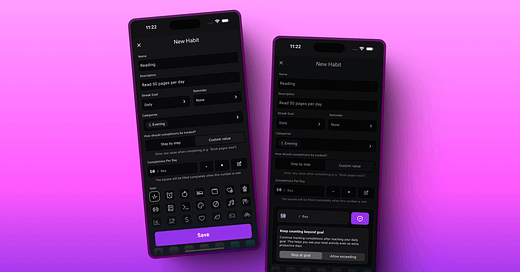Building An Indie App Business #56
New Year's success drives app growth; unlimited tracking feature coming
Welcome back to another week of me trying to build and grow a successful mobile app business. I decided to make some changes to the structure of this newsletter to make it more consistent and easier to read. The following posts will always include the following categories:
📈 Business Updates: Updates on the business, including new marketing strategies, milestones, and other business-related news.
🛠️ Development Corner: Updates on the app's development, including new features, updates, and changes.
💡 Indie Insights: Insights on the indie app business, including new strategies, tactics, and other learnings.
By adding these categories, I hope to provide a more comprehensive view of the week's activities and insights.
Let's get started!
📈 Business Updates
The New Year's hype is slowly dying down. The past 4 weeks have been absolutely insane in terms of impressions on the App Store and Google Play, downloads, and revenue. This is usually the busiest time of the year for developers who maintain a habit-tracking app like me. I received tons of emails from people who are trying to get their New Year's resolutions off the ground and have been using the app to do so. I always love to hear their success stories (and their problems with the app as well of course, because that's a huge opportunity to improve the app). In terms of revenue, every day of the past 4 weeks has been better than the most successful day of January 2024 (which was my all-time high up to that point). I'm very grateful for all the support and I'm looking forward to see how the numbers evolve in the following weeks.
This week we also get to celebrate a huge milestone: We're still climbing the ranks of the App Store. One of the most important keywords for the habit tracking space is "habit tracker". I've been able to get HabitKit to the top 5 in the US, UK, Germany, France, and Australia. The US App Store is incredibly competitive, so this is a huge accomplishment. I had to wait 2 years to even reach the top 100 and now we're pretty close to the top 3. As you can imagine, that's a huge opportunity in terms of downloads and revenue. I will keep you updated about the progress in the following weeks.
If you're curious about what I do in terms of App Store Optimization (ASO), check out my previous post where I explain what and how I do it. I'm not saying that this is the best way to do it, but it's what works for me and my app. Maybe you find it useful as well.
🛠️ Development Corner
This week, I've been working on one of the biggest changes to HabitKit since its launch: unlimited habit completion tracking. Until now, habits were limited in how many times they could be completed per day (I hard-coded it to 36). This has been a significant limitation for users who want to track quantifiable habits like "pages read" or "pushups done."
The update introduces two tracking modes that users can choose from:
Step by Step: The classic HabitKit experience where you track habits one completion at a time
Custom Values: A new mode that allows users to input specific numbers (like "50 pushups" or "30 pages read")
One of the most exciting additions is the ability to exceed daily goals. For example, if your goal is to read 20 pages per day but you end up reading 35, HabitKit will now accept your input and reflect it in your statistics. This has been a frequently requested feature, and I'm thrilled to finally bring it to life.
This update presents some crazy UX challenges. The habit edit page is already quite dense with options, and adding these new tracking modes requires careful consideration of the layout and user flow. I'm currently experimenting with different designs to make sure the interface remains clean and intuitive.
Based on recent user feedback about the first-time experience being quite confusing, I'm also taking this opportunity to rework and clarify some texts and explanations throughout the app. Although I'm sure that this feedback might represent a minority view, I believe there's always room for improvement.
This update will be part of the upcoming version 1.11 release. It's a significant step toward making a more versatile HabitKit 2.0.
💡 Indie Insights
This week, I want to share some thoughts about my approach to UX and design as a developer-turned-indie-maker. Unlike many other successful app creators who can craft beautiful mockups in Figma before writing a single line of code, my process is quite different: and that's okay!
I've learned to enjoy what I call the "iterative reality" of design. Since I don't have formal design training or the ability to create pixel-perfect mockups, my process starts with coding up the bare minimum version of what's in my head. It's usually not pretty at first, sometimes it's really ugly, but it gives me something to work with.
From there, it's all about small, incremental improvements. Each iteration brings me closer to the polished interface I had in mind. I might adjust spacing here, tweak animations there, or completely reorganize elements based on how they feel in actual use. I also polish texts and wording so often. This approach is slower than having a perfect design upfront, but it's the only method that works for me.
The hardest part: Being patient with the process. It's challenging to look at an early version and see all its flaws. But I've learned that good design, like good habits, takes time to develop. Every successful feature in HabitKit started as a rough implementation that evolved through countless small improvements. Sometimes, the best path forward is to start building, keep iterating, and trust in the process of continuous improvement.
I hope that I could spark some inspiration, see you next week! 👋




